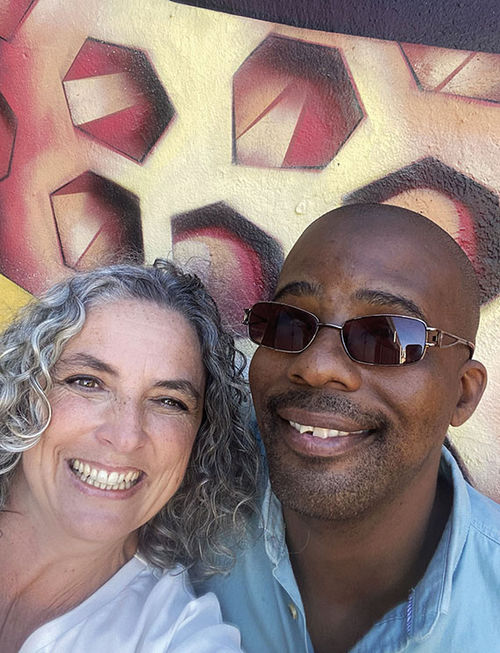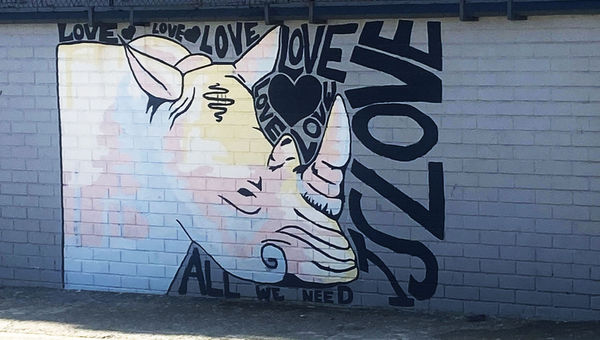The initial impressions of the taxi from Salt River, a neighborhood on the outskirts of Cape Town, were not inspired.
The place felt a bit rough around the edge. The building that peeled the paint seemed to have seen a better day. The report demanded a careful search. In other situations, it is the kind of neighbor I rushed.
But I was here to meet Winston Fani of AWOL TOURS, South Africa’s first blind tour guide. Winston was waiting for me with a wide smile. “Welcome to my office.” He smiled and reached out in my direction.
Winston said, “Most people don’t see anything after passing through this wall every day.” “But there are stories everywhere. You need to know how to listen.”
In each stage, Winston painted in words. The brilliant murals that celebrate the rainbow country have caught my eyes, or Winston’s explanation has caught my ears. Another mural showed people who work side by side by people of other races, and have spades among unclear colleagues with subtle details such as women in wheelchairs. Winston gently reminded me of “Comprehensive Castle.” “It’s really hard.”
He shared an anecdote about each artist, and many of them met while frequently visiting the current closed art studio in this area, which has raised creative talents around the world.
“This is my favorite,” he said. The murals he described were “scary people.”
“Nature is still the best technology. This is the message here. Whatever the machine we make, we remain as a master.”

The artist with the AWOL tour guides Winston Fani. Photo Credit: Dorine Reinstein
At each stop of our stops, Winston has reached a small plaque next to each mural and has been fingered through a braille explanation for blind visitors.
“I had to go to all artists and translate it as I could learn about their work and understand it,” he said. “Then I created both braille descriptions and audio recording that can be accessible through this qr code.”
He was proved to scan one of his code with his cell phone, and suddenly his voice filled the air. In addition to the visual factors, the emotions that come to mind, the history and the artist’s intentions are described as vivid details.
Winston said, “My goal is simple,” when he asked why he went to that length. “I want everyone to feel part of this journey, whether it’s a blind or not.”
His passion is contagious and deeply sincere. “I don’t feel like working,” he said. “I am pleasant to share the world. Perhaps the only blind for art tours anywhere in the world.”
History is hidden in ordinary vision

Community House’s murals of IMAM HARON are honored by anti -Apa Lert Hate activist who died during police detention in 1969
As our tour continued, we turned the corner and described Winston as a building that accommodated white women from a farm that wanted to work in Cape Town in the early 19th century. Later, it became a headquarters of the Communist Party and the Trade Union during the painful Lartheid.
On the external wall, Winston pointed out a picture depicting a miner wrapped in a green blanket. In the democratic era of South Africa, there is an artistic memory of Mari Kana University in 2012 when dozens of notable mining workers were killed by the police.
Another wall showed the noticeable murals of Lee Mom Haron. Winston said, “He was a hurry lerthaid activist.” Winston has 27 bruises and two broken ribs in 1969, how Haron died in the police. “They claimed that he had put down the stairs,” Winston said.
Inside the building, the portraits of other heroes of the struggle lined up the wall. Winston stopped for a while in a work that celebrated Jeanette School. “She was also a half -hearted lithaid activist,” he said quietly. “I died in a parcel bomb in 1984.”
The most noticeable murals are described in front of the newspaper released from Nelson Mandela’s prison. “Look closely,” he instructed. “Do you know how there is a red tie but how you have a person in your face? It’s illegal to show the face of a political criminal in the newspaper. I knew who was overview.”

Salt River’s rhino murals deliver simple but powerful messages. “Only what we need is love.” Photo Credit: Dorine Reinstein
Personal journey
Winston shared his story between the stops. The task of the wife (a blind and content writer), a travel guide, and a Tourist Guide Institute in South Africa.
“Most tourist institutions will not take me because I am blind,” he said. “But I will help me. You will show you how to do it. ‘ And we did it.
It was a coincidence that Winston started the tour. As AWOL’s Wendy Purdon said, she and her best friend, Tania, visited Winston and his wife, Busi. Tania wanted to raise the guide dogs of the Busi and see how everyone is doing. But in the process, Wendy and Tania were lost.
Purdon said, “We called Winston.” I joked to him, “You should be a travel guide.” Winston replied, ‘I always wanted to work in sightseeing.’ … so we started with a dream that we appeared in reality. “
Purdon and her friend actually collected the tours led by Winston and kept walking with him until they memorized.
Purdon said, “There was no hesitation to work with Winston from the beginning.” Winston is smart, fun, favorite, responsible, future -oriented, and all attributes we find in the travel guide. “
When we approached the end of the tour, Winston led the murals depicting the rhino with the word “Everything we need is love.”
“We had three different rhinos,” Winston said. “Now we have only one. I am afraid that the next generation will not have luxury to see this beautiful creature.”
The irony did not lose to me. A person who has never seen a rhino expressing concern that future generations will not see any. It was a strong reminder that gratitude and preservation transcend their eyesight.
During our walking, Winston once seemed uncertain his way. The neighbor was clearly mapped to his heart with the precision of my own space perception. Winston explored all of them with accidental trust of all uneven packaging stone, all parking, partially parked and converting potential obstacles to a familiar landmark.
Unfortunately, Winston admitted that it was much shorter when the tour first set the experience. As the building was rebuilt and the walls changed, much of the original wall art disappeared. But Winston does not give up. Instead, he plans to expand the tour to include tasting experience. The concept of “My Wine Tour” mentioned that his other field of specialty was a wine taste.
This adds to the more doubtful experience, complementing visual and historical elements with a sensational taste and smell. When we went on the road, Winston promised, “We will prepare the tasting when we are in Cape Town.”
When I returned to the taxi at the end of the tour, I realized how differently I saw Salt River when I arrived. I first felt it was full of life and meaning. Thanks to Winston Fani, I saw the side of Cape Town, which most visitors miss.


